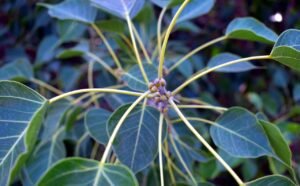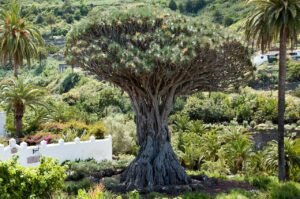
Protecting Endangered Tree Species: Strategies for Conservation
Table of Contents
Our planet’s health often necessitates the presence of trees. Through oxygen provision, carbon storage, soil stabilization and facilitating numerous forms of life. In this regards, it is necessary to mention that there are many tree species that are currently endangered due to different factors like deforestation, habitat loss, climatic changes and other invasive species.
Preserving biodiversity, maintaining ecosystems’ equilibrium, and safeguarding the future of all living organisms on earth call for protection of endangered types of trees. In this article, Different methods to save endangered species and their significance will be illustrated.
Understanding the Importance of Trees:
It’s critical to comprehend why trees are vital to the earth before examining ways to safeguard endangered tree species.
Oxygen Production:
Photosynthesis is a process in which trees play a critical role in supplying the air we breath with oxygen by absorbing carbon dioxide and releasing oxygen that supports the survival of every aerobic organism.
Carbon Sequestration:
By absorbing carbon diodes from the atmosphere as well as storing them in their biomass, trees act as carbon sinks thus helping in moderating global weather changes through minimizing concentrations of greenhouse gases in air.
Habitat and Biodiversity:
Trees harbor a wide variety of living things, among them being birds, mammals, insects, and fungi. Habitats of a sophisticated nature are maintained by them which enhances biodiversity through offering refuge, nesting places, and nourishment for different creatures.
Soil Stabilization:
Trees usually maintain soil fertility and prevent soil erosion through their root systems which anchor soil, reduce risk for landslides and control water movement.
Economic and Cultural Value:
Trees have significant economic value, providing timber, fuelwood, medicinal products, and other forest resources. They also hold cultural and spiritual significance for many communities around the world. Since trees play a critical role in supporting life on the planet, it is important to initiate action aimed at keeping certain tree species that are almost disappearing from getting extinct.
Challenges Facing Endangered Tree Species
Endangered tree species face many dangers that undermine their existence. Some of the main problems are:
Deforestation: One of the primary challenges facing tree species across the world is the massive threat posed by forests clearance for agricultural purposes, urbanization, timber harvesting, and development of infrastructure. This activity leads to destructions of certain areas with some species vanishing as others shifting their niche to new environments or simply dying out.
Habitat Destruction: Fragmentation and natural habitats degradation happen due to human activities like mining, construction, and land conversion. As A result, this has led to decreases in some endangered tree species. The vulnerability of species to extinction tends to increase as a result of species having a hard time scattering and reproducing in fragmented habitats.
Climate Change: Global warming represents a major threat to tree species due to temperature changes and changes in precipitation amounts leading thus to habitat suitability transitions, all coupled with harsh weather occurrences like dry spells, floods or storms becoming more frequent every day causing lots of destruction across the world. The life cycles of trees as well as those of their companions may be altered hence decreasing their numbers in terms of the population and range size as a result of climatic changes.
Invasive Species: The survival of endangered trees and other native flora and fauna is threatened by the coming of species that are not local and that tend to spread diseases, disrupt ecological processes and outcompete native trees for resources.
Illegal Logging and Trade: Threats that make serious are posed by illegal logging and trading timber and such forest products to certain endangered tree species. Poaching and the illegal harvest contributes to habitat destruction because they result in declines in populations that are already
vulnerable which increases the risk of extinction. To tackle this, a blend of protection techniques should be incorporated so as save and promote the eco-systems for the at-risk trees; some effort should also be made towards lessening effects brought by human beings as well as involving indigenous individuals in the conservation.
Strategies for Protecting Endangered Tree Species:
Habitat Protection and Restoration:
One way to save endangered tree species is by conserving their natural habitats, ensuring they are not exposed to further degradation or destruction. These can be secured by setting aside protected areas, national parks, wildlife reserves, and forest sanctuaries, in which logging, mining and other destructive activities cannot take place. There is also a need for people to plant trees in order to rejuvenate areas where vegetation has become scanty due to soil erosion and human encroachment.
Community-based Conservation:
For long-lasting achievements in saving rare plant species, it is extremely important to stimulate population activity. Traditionally, village communities generally preserve wisdom that is helpful during protection and sustainable use of forests.
These are collaborative strategies incorporating local people into the process of making decisions, and introducing other ways of earning for them, Encouraging the sustainable utilization of forest resources and supporting conservation efforts can in turn increase the public’s backing for it as well as promote taking care of natural resources.
Invasive Species Management:
It is very important for conservation to Control and eliminate invasive plants endangering endangered tree and their habitats; different strategies include the use of physical, chemical, sanitary or biological control measures, emergency introduction of the quarantine. Intercepting new entrants followed by quick action constitutes the first-line defense that doesn’t give an opportunity for damaging existing eco-systems through incorporation into them invasive plants.
Law Enforcement and Policy Development:
It is crucial to prevent the destruction of endangered tree species and their habitats by strengthening regulations on illegal logging, and trading in protected tree species. Imposing strict penalties on poaching, smuggling of such tree types can stop many of those who get involved in illegal acts thus reduce the use of forest items from unapproved sources.
However, governments and those who create policy are expected to come up with laws and encouragements that make the usage of the land sustainable, which is necessitated by planning for the conservation and adopting ecosystem-oriented mechanisms for taking care of resources from natural sources.
Research and Monitoring:
It is crucial for informed decision-making and adaptive management to carry out scientific research in order to observe trends and status of populations of endangered tree species, evaluate threats and conservation interventions.
Monitoring programs can help recognize priority areas for conservation, evaluate the effectiveness of conservation actions taken, and direct future conservation strategies. Research projects that focus on the ecology, biology, and genetics of endangered tree species can produce useful information on what they need for conservation purposes and also guide decisions on how trees should be conserved.
Education and Outreach:
In order to attract the public’s attention and encourage conservation-oriented behavior, one should emphasize on the significance of protecting endangered tree species and their habitats. While people may not know how trees are important, why they are disappearing or what they can do about them, it is through education programs,
community outreach efforts as well as engagement projects within communities that more individuals will be sensitized about the importance of trees, challenges facing them as well as the means through which each person can help in conserving them. Through encouraging individuals to make informed decisions and practice sustainability, education has the potential to encourage collective action and responsibility for the environment.
Genetic Conservation:
Creating off-site maintenance methods such as seed banks, botanical gardens, as well as living gene banks can aid in preserving the gene pool of tree spices that are on the verge of extinction.
The act of gathering and stocking seeds or plant tissues from different populations helps to retain the genes’ diversity and can be utilized during restoration and reintroduction in future efforts that involve trees which are disappearing. It can also help in carrying out researches related to breeding, hybridization and genetic improvement of endangered tree species that can enhance their ability to withstand environmental stresses and threats.
International Collaboration:
For addressing trans boundary conservation challenges and protecting globally threatened tree species, it is necessary to collaborate with international organizations, governments and stakeholders across borders. The Convention on International Trade in Endangered Species of Wild Fauna and Flora (CITES), the Convention on Biological Diversity (CBD) and other international treaties, agreements and conventions.
The International Union for Conservation of Nature (IUCN) Red List can provide the basis for cooperation, exchange of information and joint activities in conserving priorities. Working together on a planetary scale provides the chance to take advantage of conservation resources, expertise and commitment from political leaders to preserving rare or endangered tree species in the wide range of their habitats.
Climate Resilience Planning:
The resilience of endangered tree species to changing environmental conditions can be improved by incorporating techniques that are aimed at adapting to climate change in conservation planning. This may require the identification and protection of climate refugia in the future, which are areas that are projected to remain relatively stable or suitable for species survival. Conservationists can give precedence to tree species conservation.
This can be achieved by focusing on the species with genetic diversity, phenotypic plasticity, and adaptive capacity which enable them to tolerate or adjust to changing climatic conditions. Moreover, planting species resilient to climatic conditions would place an emphasis on re-growing trees and bringing native habitats back to life with better resilience to the devastating effects of global warming .
Corporate and Industry Engagement:
Involvement in private sector companies and industries that depend on trees for their resources can significantly contribute towards advocating for sustainable environmental practices and minimizing adverse repercussions of economic undertakings on threatened tree species as well as their habitats. If companies are involved in corporate partnerships,
Forest Stewardship Council (FSC) certifications are recommended while there are other ways like promoting sustainable supply chains. By using the power and resources of businesses, conservation organizations can harness market forces for encouraging positive change and promoting sustainable forest management that benefits people and nature. To decrease the rate at which forests are destroyed as well as the rate at which animals lose their homes; there must be concerted efforts to conserve or restore some parts.
Integrated Landscape Management:
The adoption of an integrated landscape strategy for conservation will help in communicating conflicting interests in land use at the same time preventing the extinction of trees and habitat where they occur. Integrated landscape management is about coordinating conservation initiatives over the various land uses and stakeholders in the same landscape or seascape, such as conservation areas, production forests,
agriculturalland, urban centers and water points. When practitioners consider the ecological, social, economic, and cultural dimensions of landscapes, they are able to figure out win-win solutions that reconcile conservation objectives with sustainable development goals, ensure connectivity of ecosystems while increasing landscapes, resistance to environmental changes.
Long-term Monitoring and Adaptive Management:
Essentially, it is essential to put in place long-term monitoring programs and adaptive management strategies since the only way of assessing how effective conservation initiatives are, watching endangered tree species populations’ status shifts with time as well as making changes in management using fresh data and feedback that comes.
By adopting a learning-by-doing attitude and constantly improving conservation actions using scientific evidence plus experience. The information derived from such monitoring contributes to understanding of population trends,
status of habitats and how successful measures are in ensuring the conservation goal is met, hence allowing for management’s informed decisions and adjustments where appropriate. In order to ensure that protection of endangered species of trees and preservation of biological diversity is successful for the generations to come, we need to employ advanced technology.
In Conclusion, One way to help protect these trees is by making sure that their homes remain safe; people should look after them so that they are not cut down just because somebody wants land which might not belong even to them anyway since habitats.
where other animals depend on them for survival are destroyed being used up with no good reason thus leading into extinction amidst other reasons without considering consequences we will be left with nothing to enjoy but rather face fear in one way or another but still pretend like there is no problem with cutting all down when we think heavy loggers control everything around us ,
who knows what species they contain but probably dirt or water used fresh or dried up not trees Air it’s irrelevant if you say that their absence cannot cause an epidemic anywhere all over. We can do this by conforming with the global system of protecting endangered tree species and the ecosystems that they live in.
It is a matter of fact that conserving trees that are found on earth may act as barrier towards poor health and decreased resilience within landscapes, as well as guaranteeing plausible future generations. By working together and being committed to this cause, we will impact positively on saving dying trees as well as helping save other life forms from becoming extinct.




